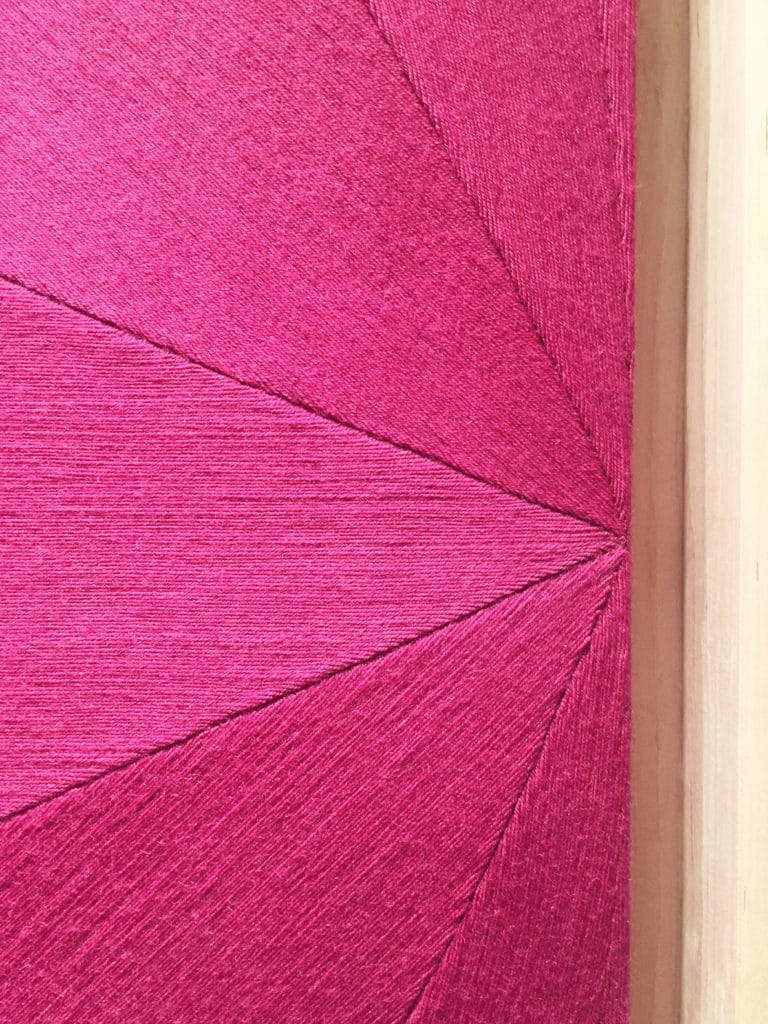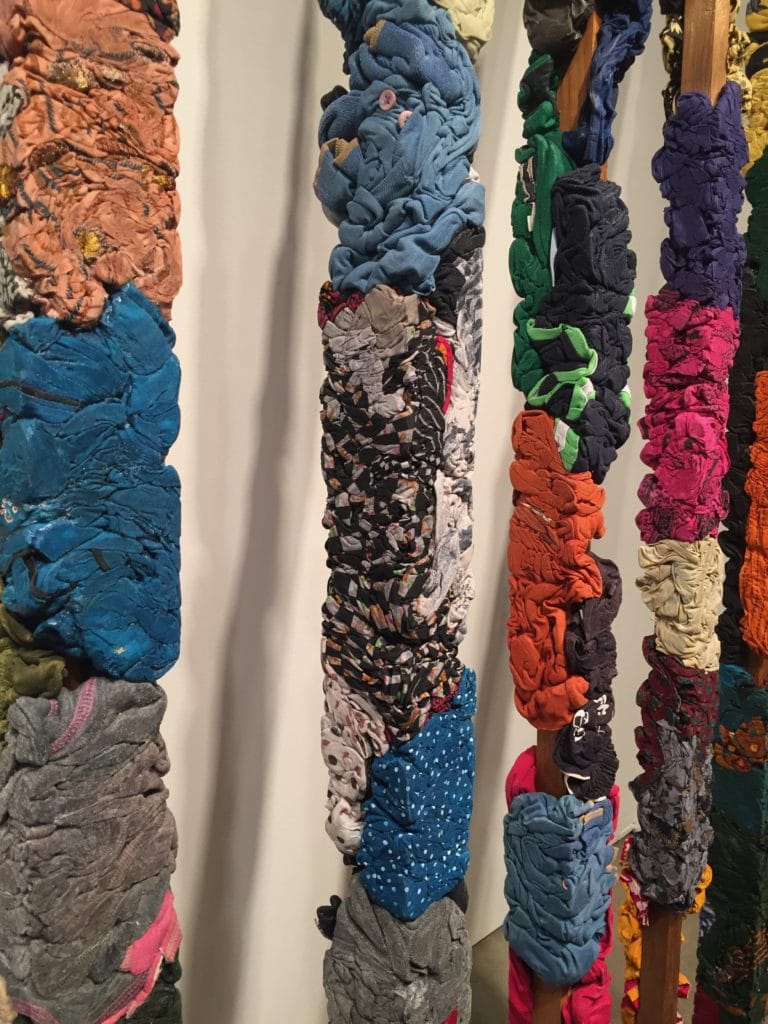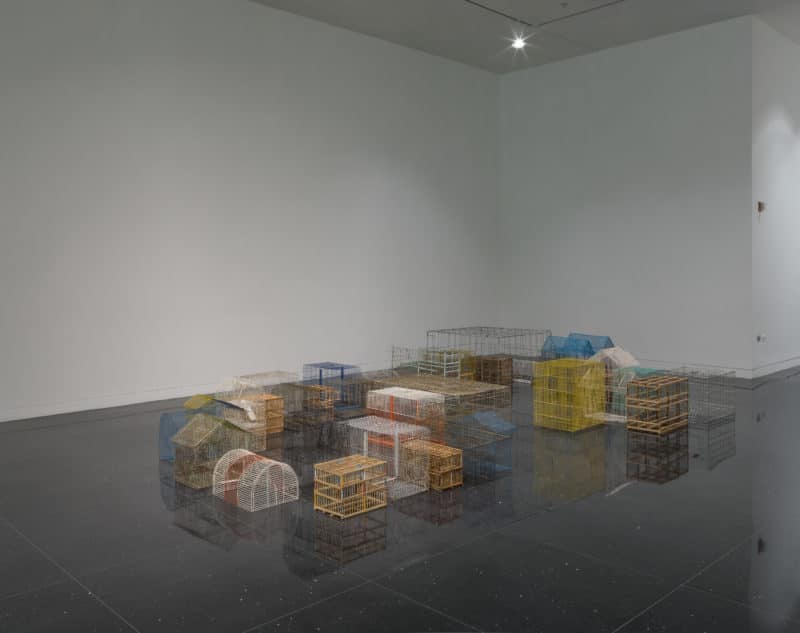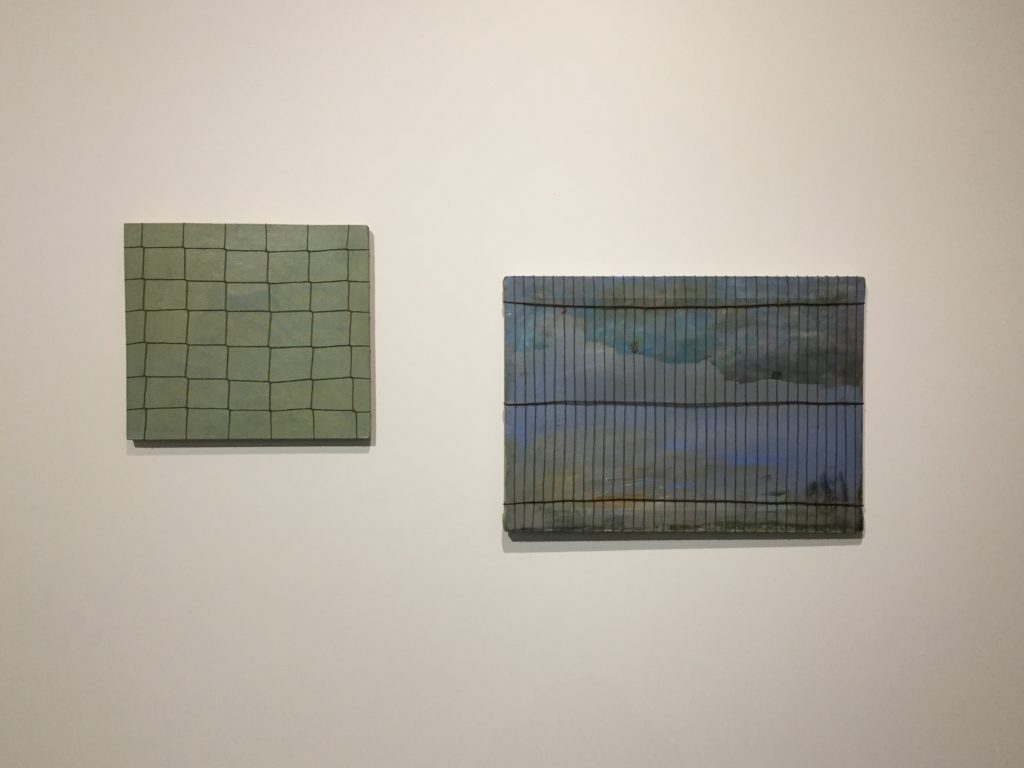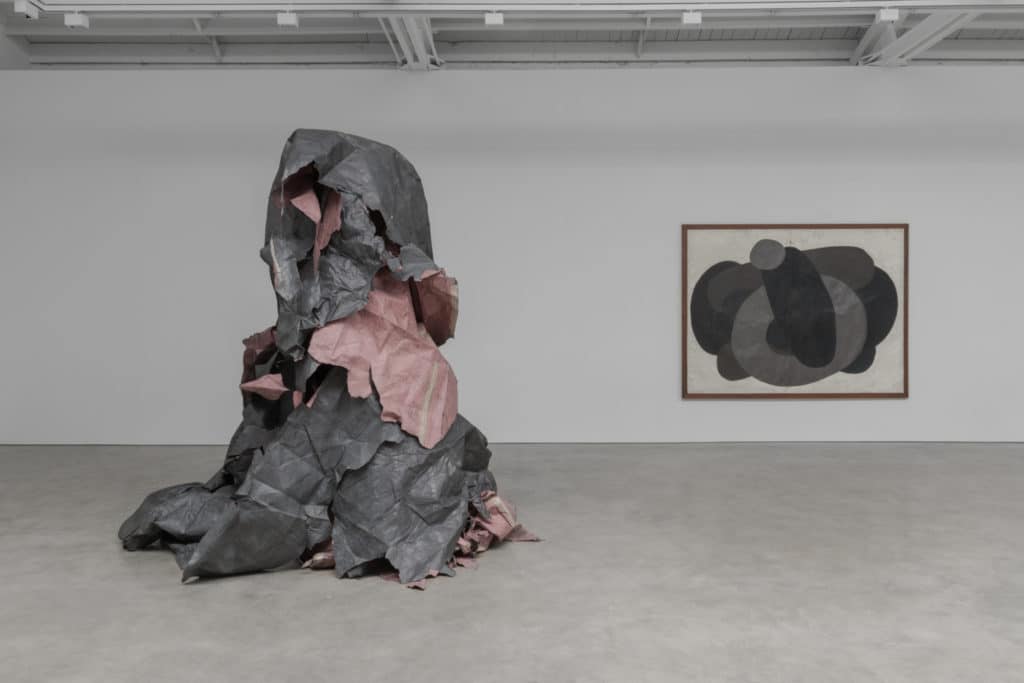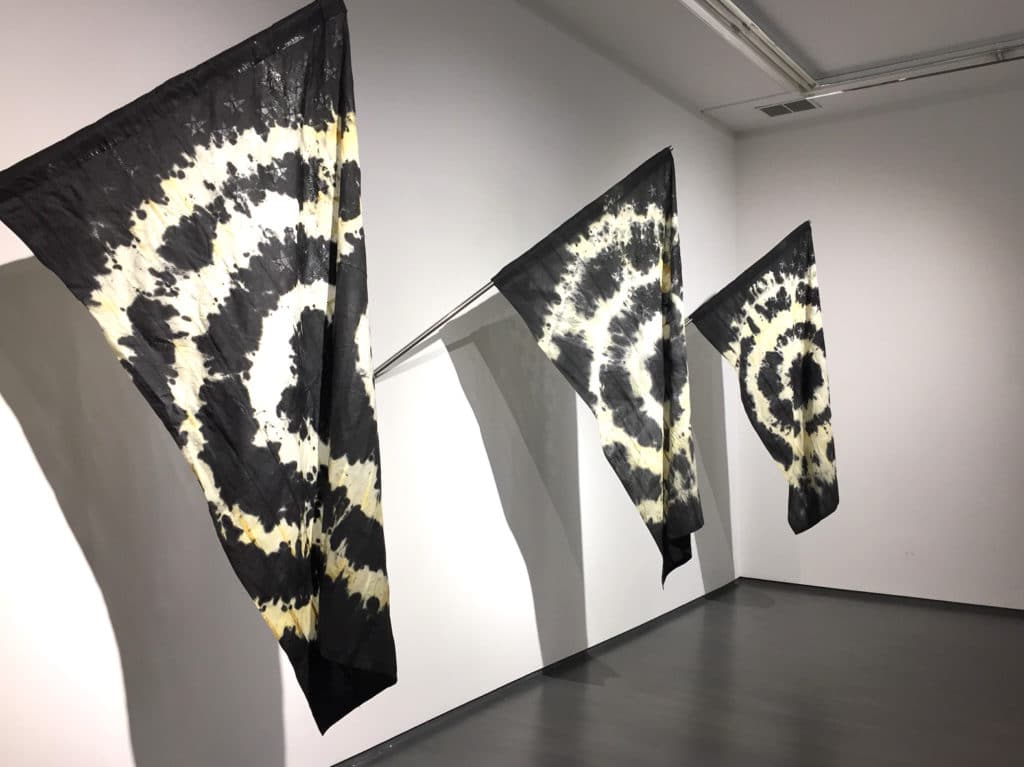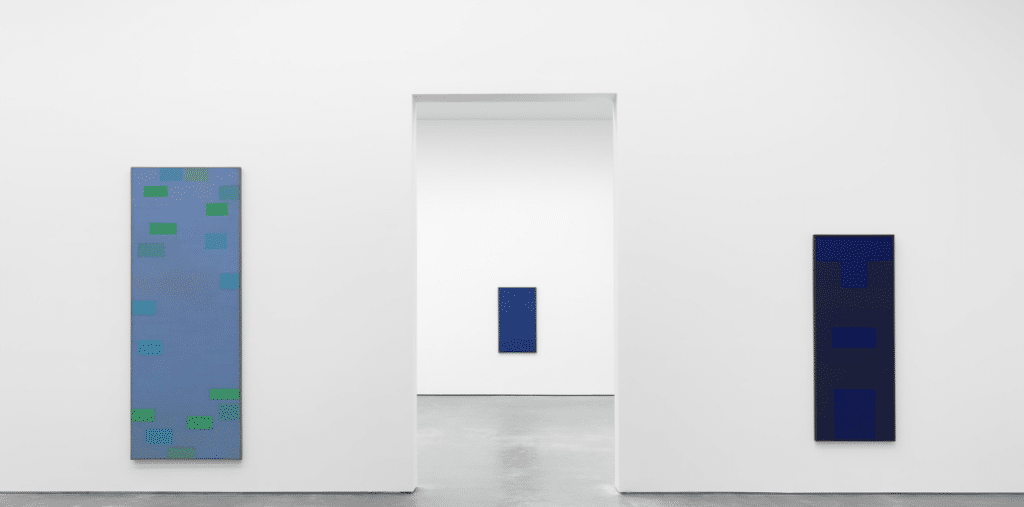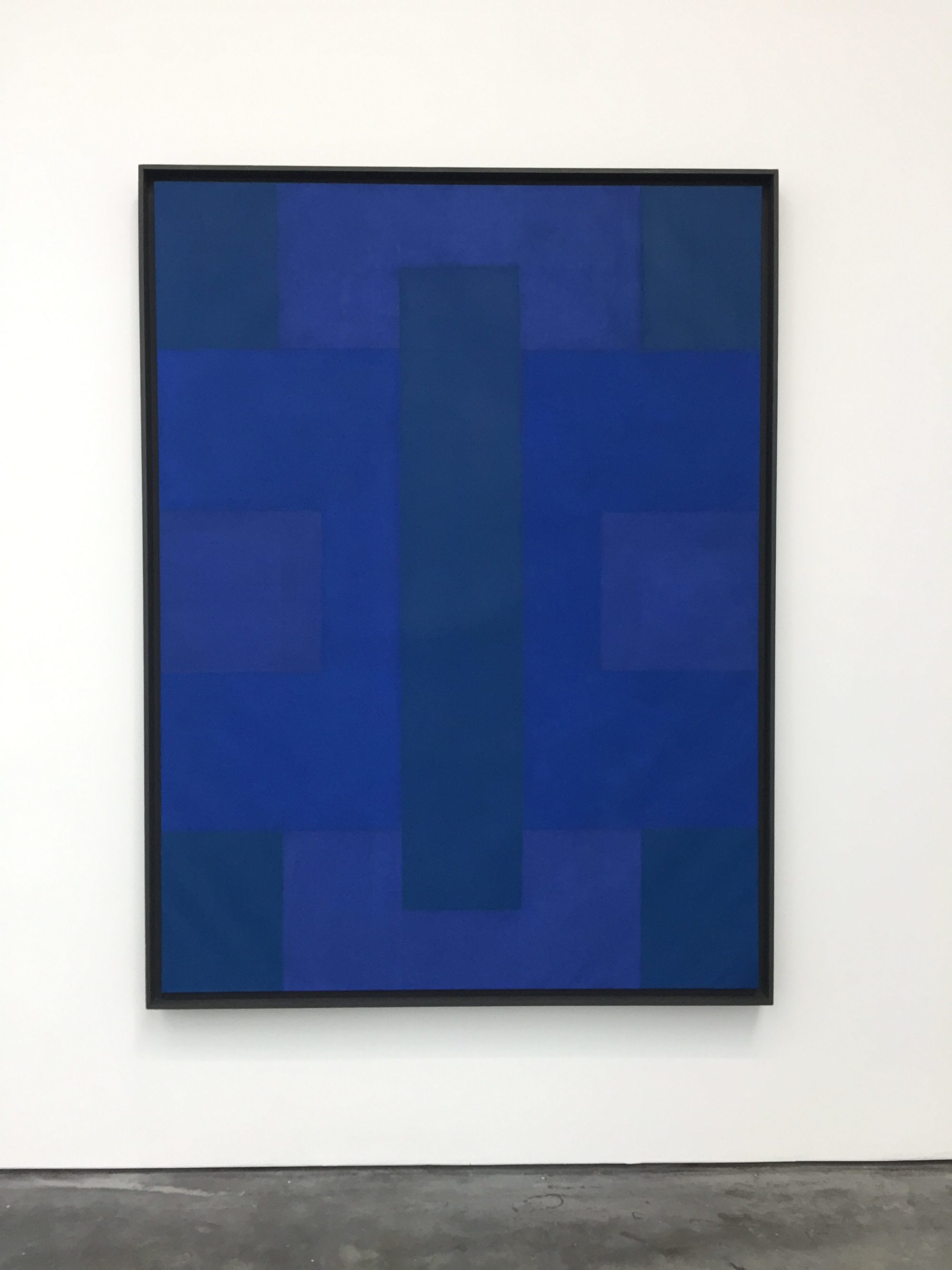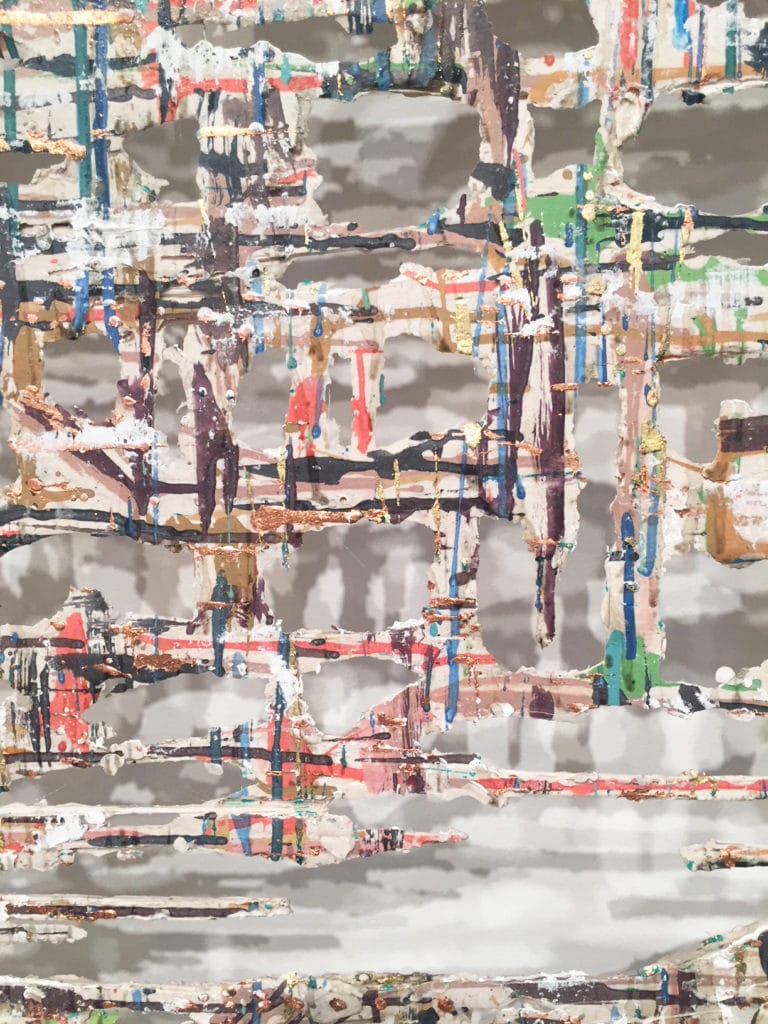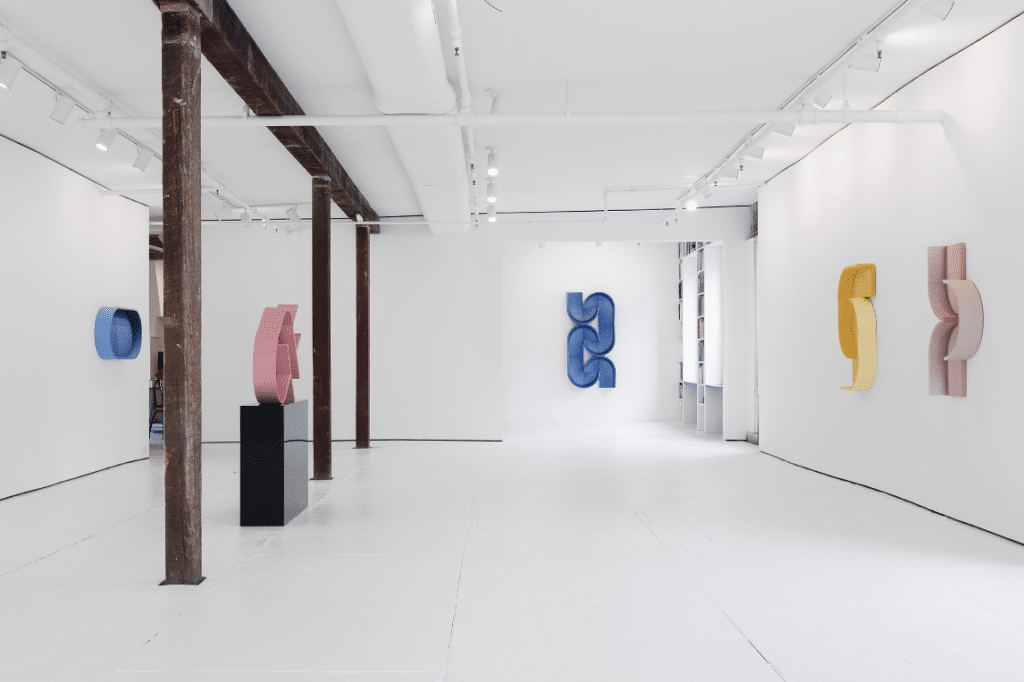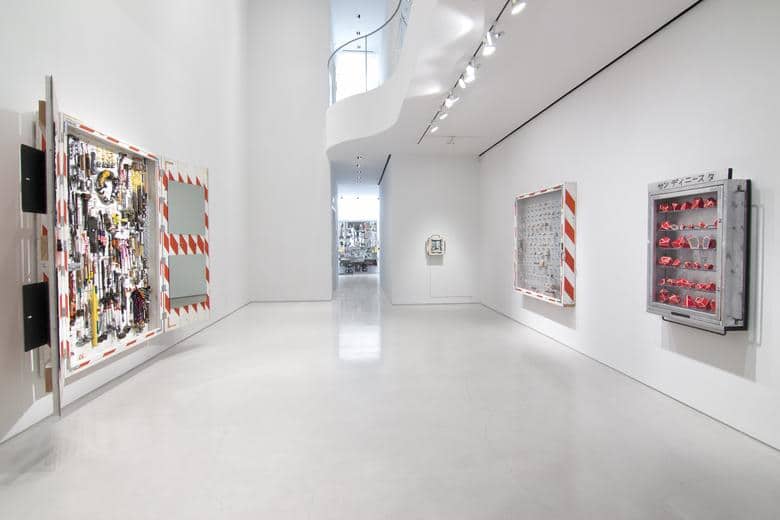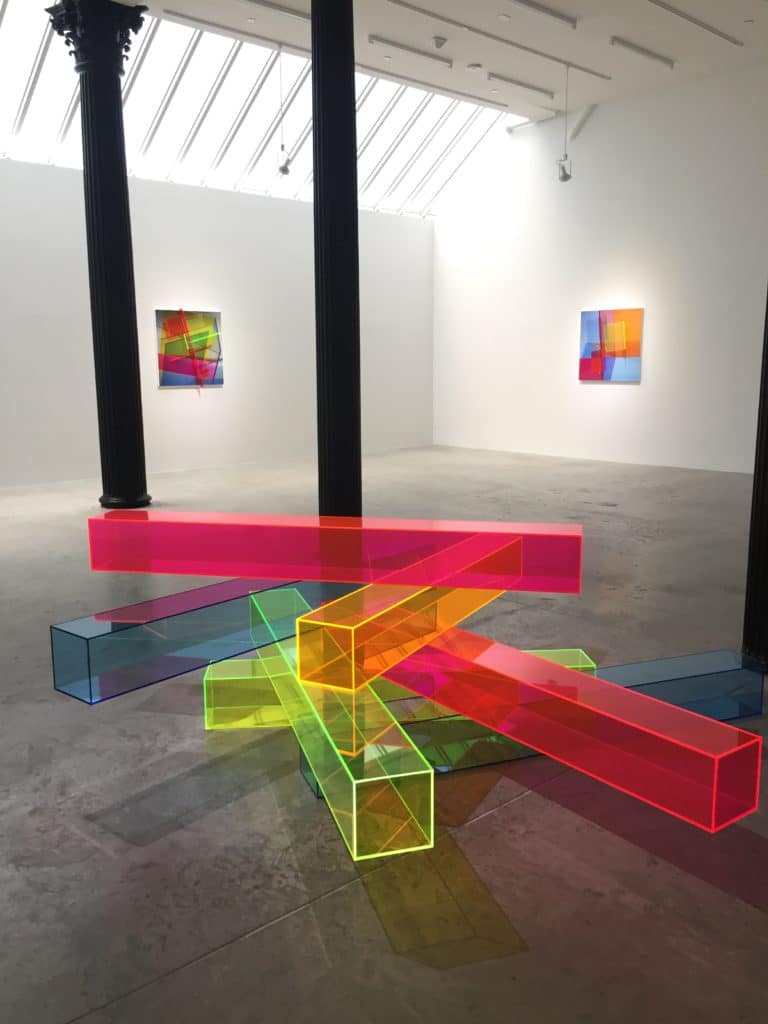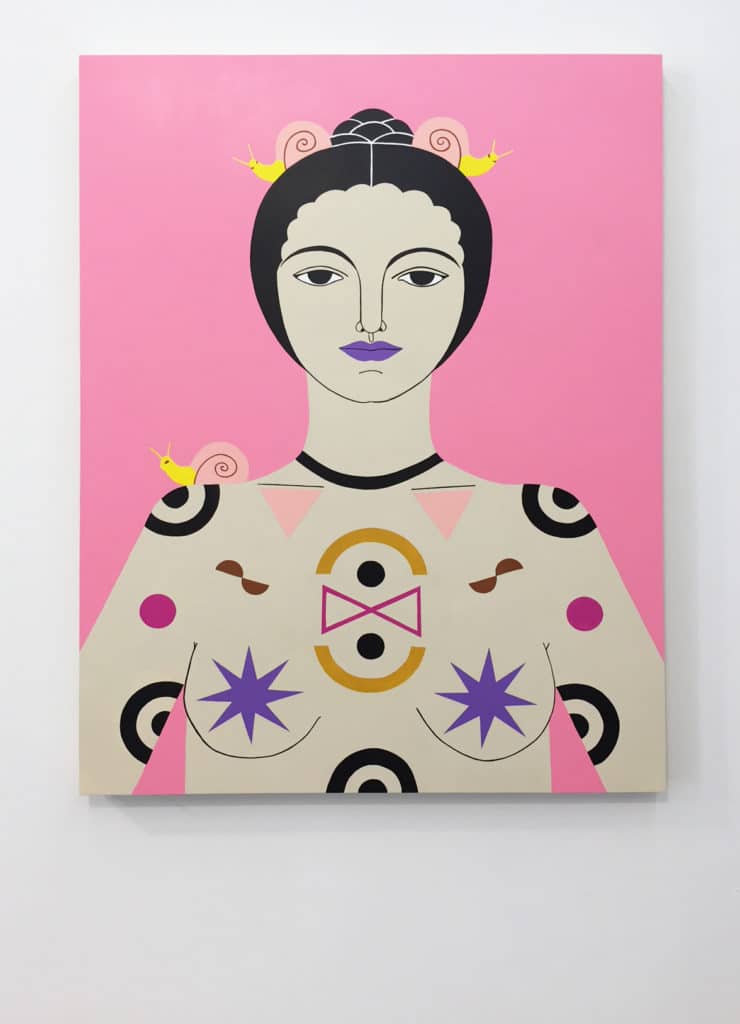EXPO Chicago Art Fair
Initiating the fall art season each September, the EXPO Chicago Art Fair hosts leading art galleries alongside high quality programming for global, contemporary art and culture.
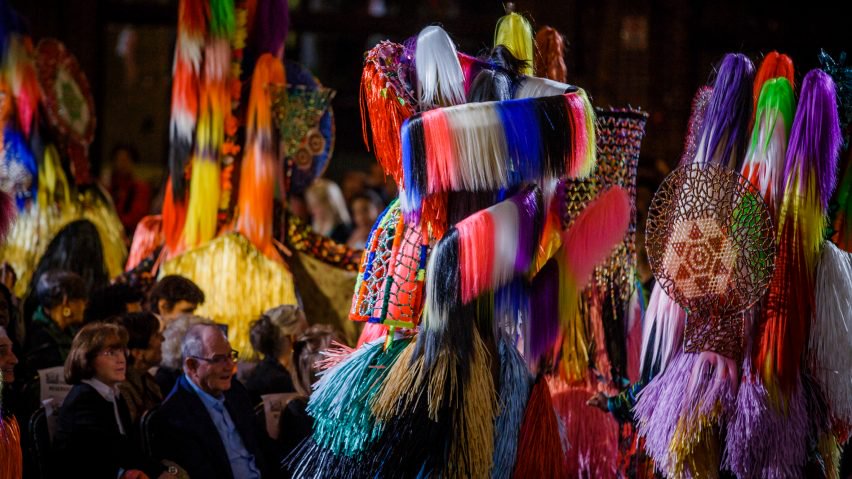
Nick Cave and Jeanne Gang, “Up Right Chicago”, 2017, performance. At the Navy Pier at EXPO Chicago Art Fair.
On the opening night of the fair, artist Nick Cave and architect Jeanne Gang presented a live production entitled Up Right Chicago featuring music by jazz artist Kahil El Zabar. The performance was a debut of their project series Here Hear Chicago. Dancers were dressed in elaborate Soundsuits created by Cave. The sculptural costumes camoflage the body, masking and creating a second skin that conceals race, gender and class, forcing the viewer to look without judgement. The dancers interacted with custom fabricated Stage Buoys designed by Gang and her practice, Studio Gang. The result was an electric and unforgettable performance.
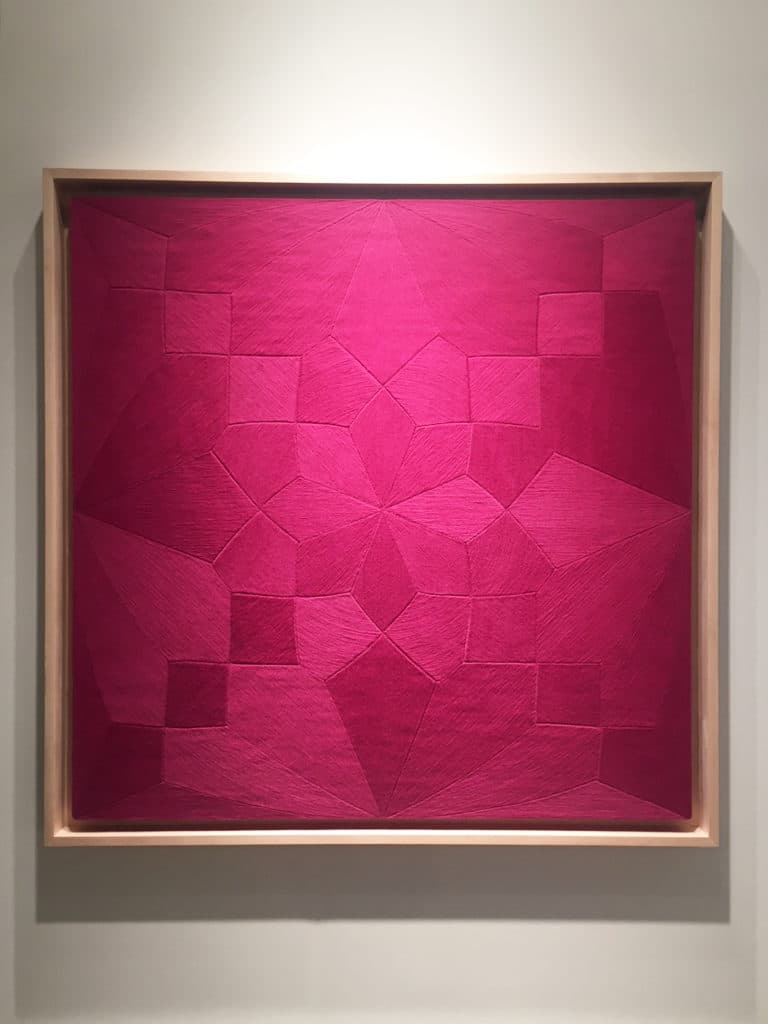
Eduardo Terrazas, “1.2.49, from the series Possibilities of a Structure”, 2017, wool yarn on wooden board covered with Campeche wax. At Proyectos Monclova Gallery at EXPO Chicago Art Fair.
For Eduardo Terrazas, the application of craft is an essential ontological process, which he deems particularly poignant in the 21st century. The Huichol yarn technique, in which colored yarn is arranged on wax-covered boards, has been adopted by Terrazas not only for its aesthetic properties, but also because of its laborious demands, which requires absorption in the act, and therefore meditation within the process.
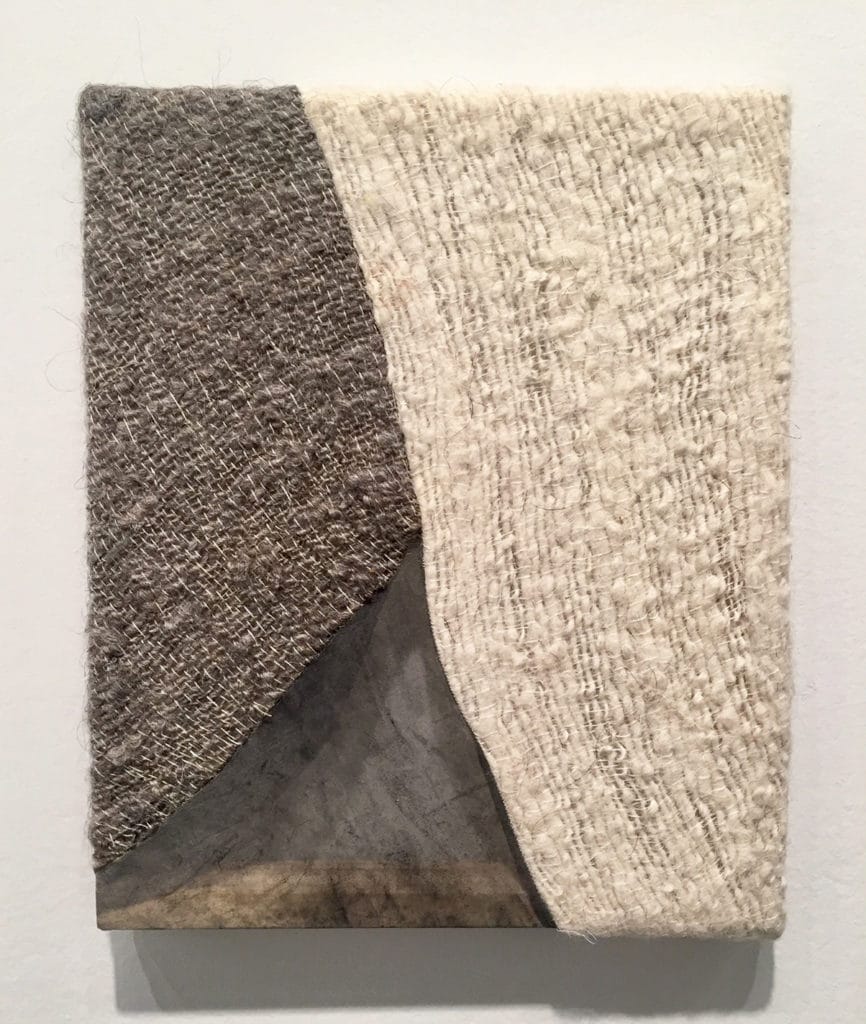
Martha Tuttle “Like Water I have no skin”, 2017, wool, silk, dye, graphite. At Rhona Hoffman Gallery at EXPO Chicago Art Fair.
Using paper, natural dyes, and tapestries that she weaves herself, Tuttle’s wall hangings exist in the space between painting and sculpture. You might even say her work is reminiscent of craft- the artist feels strongly about being “hands on” and able to touch every part of what she makes as a way to heighten the relationship she has with it.
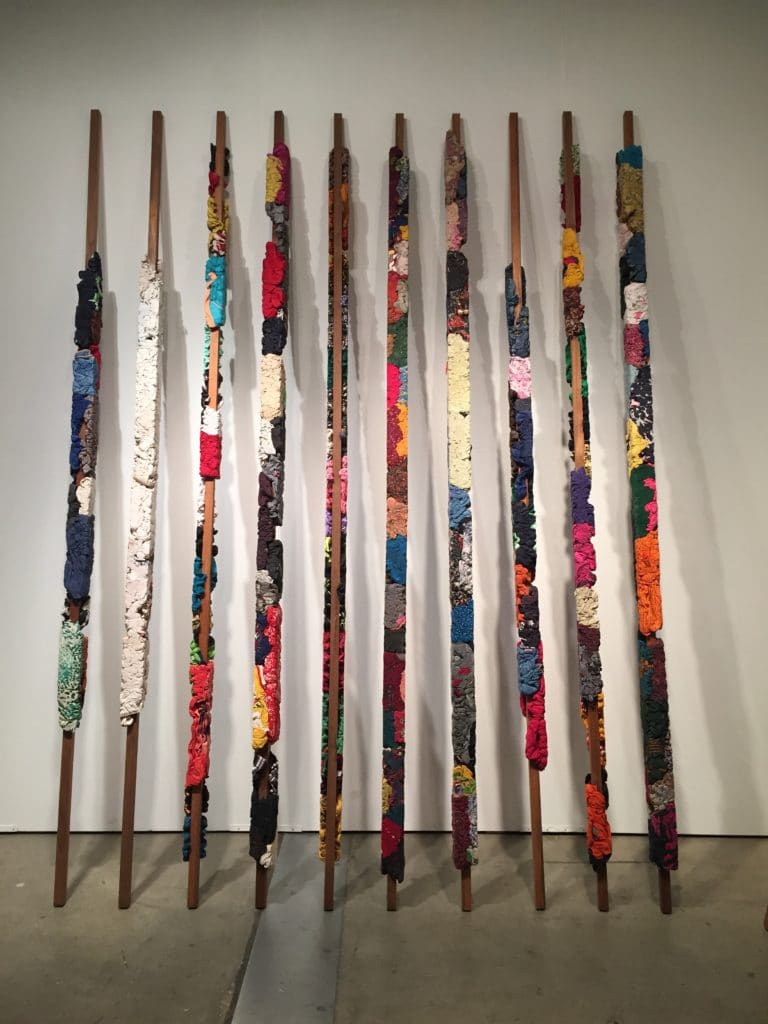
Manish Nai, “Untitled”, from the series “Part of unique series of sets of pillars in various sizes and configurations”, 2017
Pillars formed by pressing and binding together used clothes from people of differing ages and backgrounds lean systematically against the wall. Closer viewing reveals the individual histories embedded in each item of clothing. Referencing the totemic sculpture of the 20th century, these geometric forms turn notions of objectivity upside down with their colorful and biographical material. The above installation is part of In-Situ, a curated group of large-scale installation works featured throughout the fair. Courtesy of Kavi Gupta Gallery.
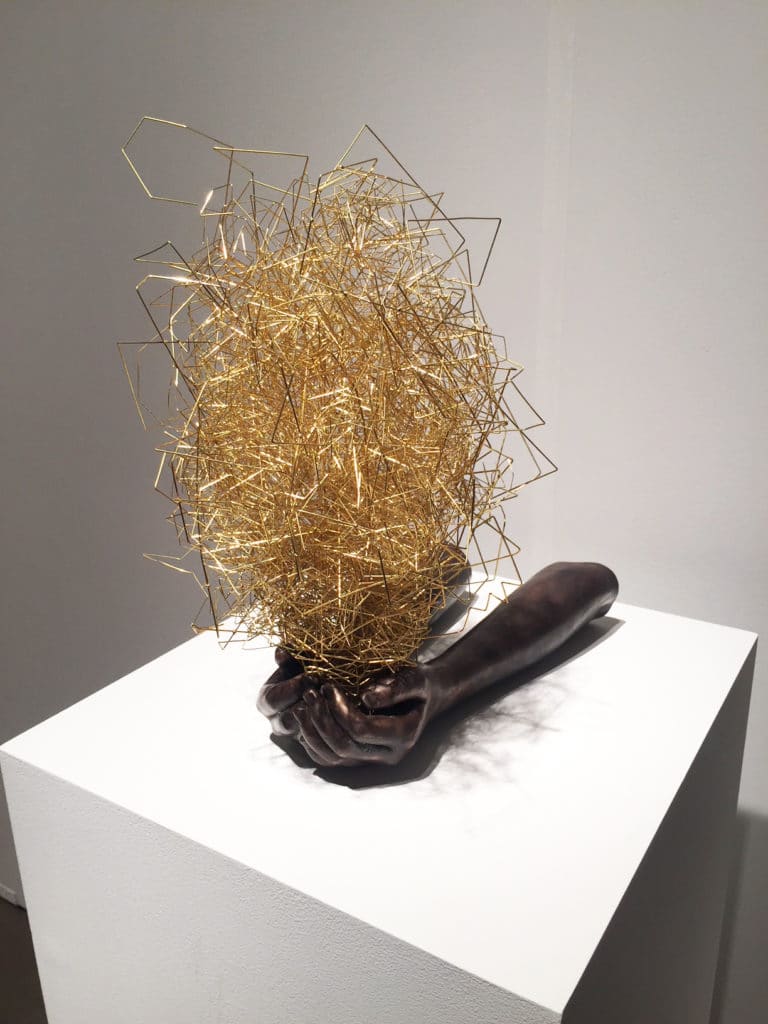
Chiharu Shiota, “In the Hand”, 2017, bronze, brass, wire and lacquer. At Templon Gallery at EXPO Chicago Art Fair
Chiharu Shiota’s radical and protean artistic approach explores the notions of the body, temporality, movement, memory and dreams.
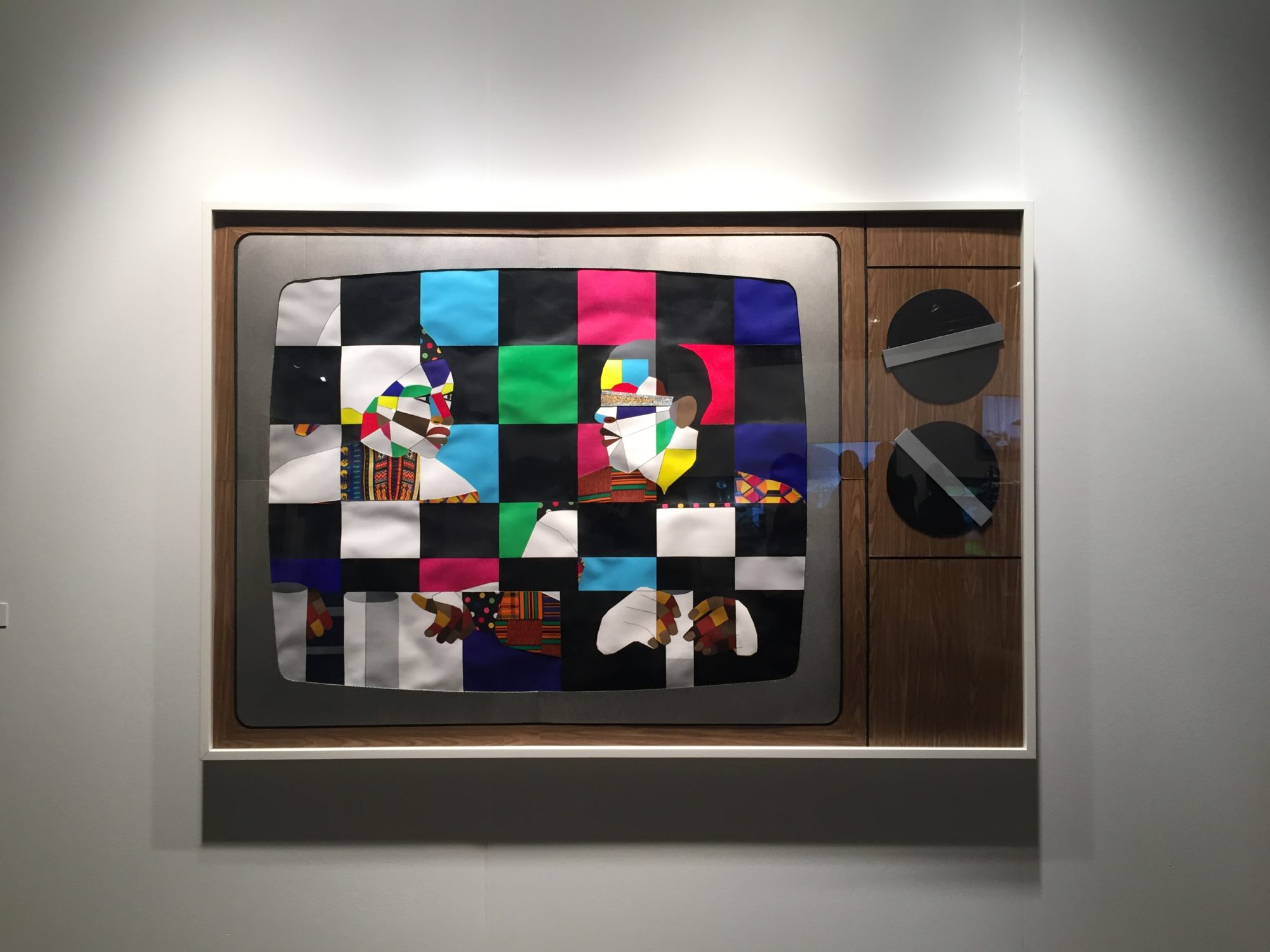
Derrick Adams, “We’re Still Here”, 2015, mixed media collage on paper. At Rhona Hoffman Gallery at EXPO Chicago Art Fair.
Derrick Adams is a multidisciplinary artist working in performance, video, sound and 2D and 3D realms. His practice focuses on the fragmentation and manipulation of structure and surface, exploring self image and forward projection.
Chicago Exhibitions
For The Arts Club of Chicago, Roman Ondak gathers four sculptural installations that have never been shown in the United States along with an ongoing series of paintings begun in the 1990s, most of which were produced expressly for this exhibition. Taken as an ensemble, this work deploys found materials to reflect on aspects of memory and place–indicating Ondak’s rather ambivalent stance toward the legacy of the readymade.
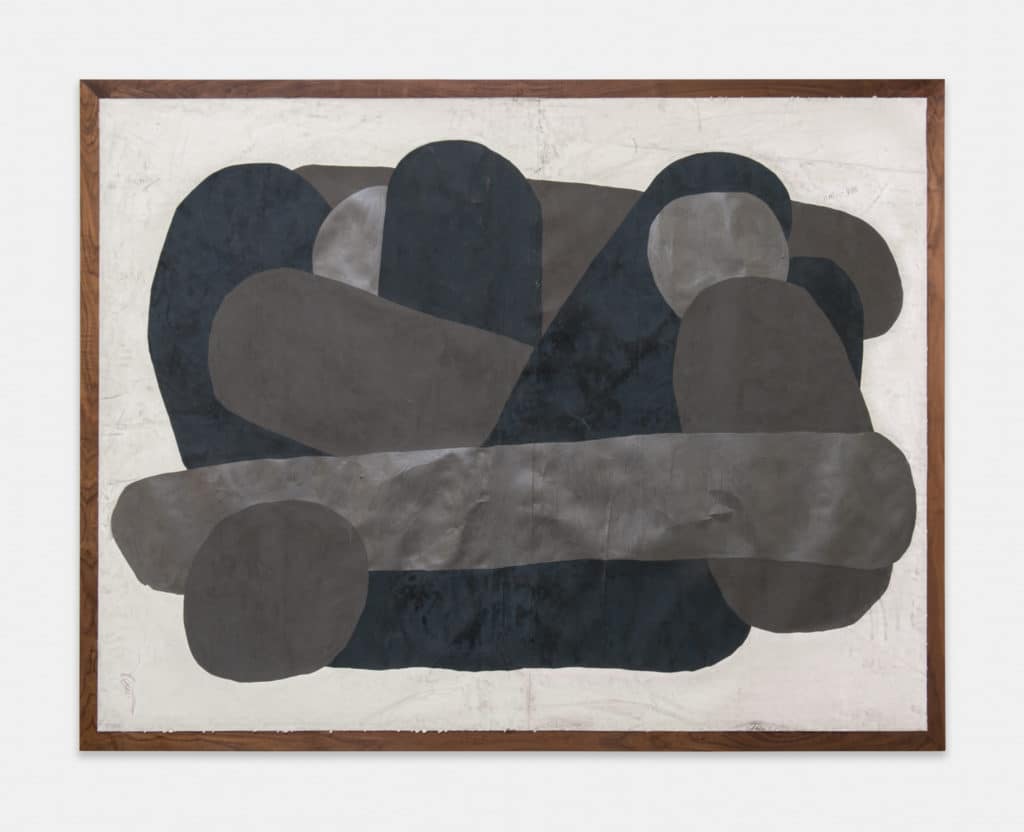
Tony Lewis, “Hm Hm!”, 2017, graphite, pencil, and colored pencil on paper mounted on wood. At Shane Campbell Gallery in Chicago.
Tony Lewis advances the relationship between improvisations of color and language within this recent body of large graphite and colored pencil drawings. These works on paper utilize a decidedly darker palette of browns, greys, and blacks which mirror the artists visual vocabulary.
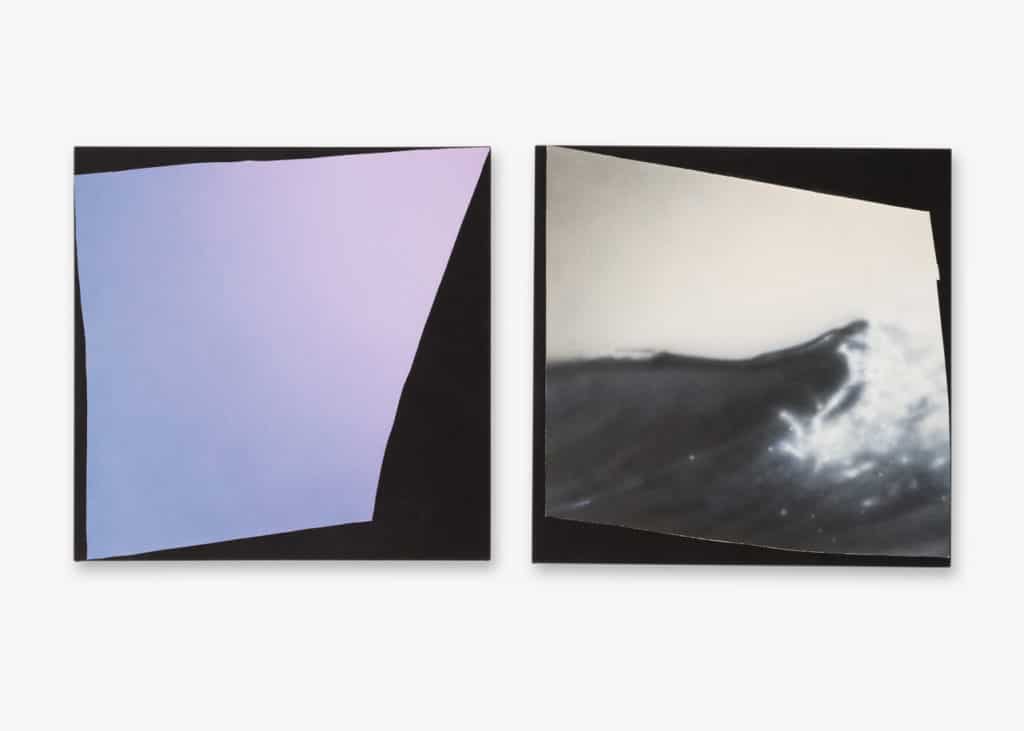
Kim Fisher, “Magazine Painting (Blue to Violet Fade)” and “Magazine Painting (Wave)”, 2017, oil and aluminum on dyed linen. At Shane Campbell Gallery in Chicago.
Shane Campbell gallery – back room surprises included Kim Fisher’s painting based on her own paper collages. The artist deftly renders her compositions—usually sourced from fashion magazines, newspapers, and shopping bags—through a methodical process of layering oil on linen or cut-aluminum shapes on linen.
We had a great face to face with the ever fascinating, Glenn Kaino on the morning of his opening at Kavi Gupta Gallery in Chicago. He described how his flags began with pure white recreations of the American flag, that were then tie-dye soaked with a Civil War-era tarring solution. Simply left alone, the fabric heats up as the oxidation of the chemicals creates an exothermic reaction. This spontaneous combustion appears as a symbolic representation of the volatile nature of this time of crisis. The resulting pattern is a beautifully poignant image of concentric circles, a target, alternating black, tan and white. Under the light of examination, the shadows that the flags cast represent the American flag as clear and pristine as a new flag might—a poetic reminder that even during our most unstable and explosive time, the ideals that exist within our concept of our country might still be preserved.
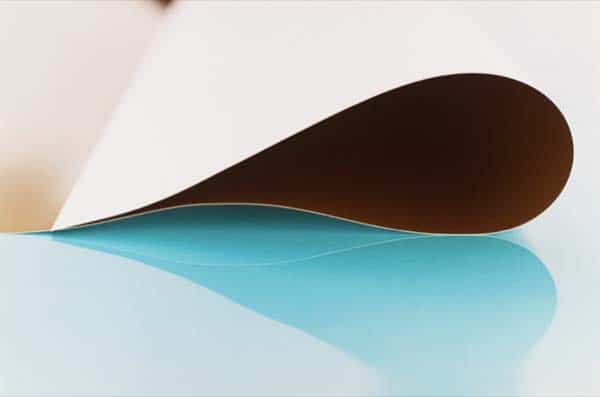
Wolfgang Tillmans, paper drop (shine), 2006, inkjet print on paper, clips. David Zwirner Gallery at EXPO Chicago Art Fair
Wolfgang Tillmans’s work is distinguished by unabashed emotion and a tension between strangeness and familiarity. Using all the photographic technology at his disposal, Tillmans shoots portraits, still- life’s, and landscapes in which the subjects range from partially-nude friends in seemingly private moments to beautiful arrangements of paper.
New York Exhibitions
Below are some highlights from our time in New York:
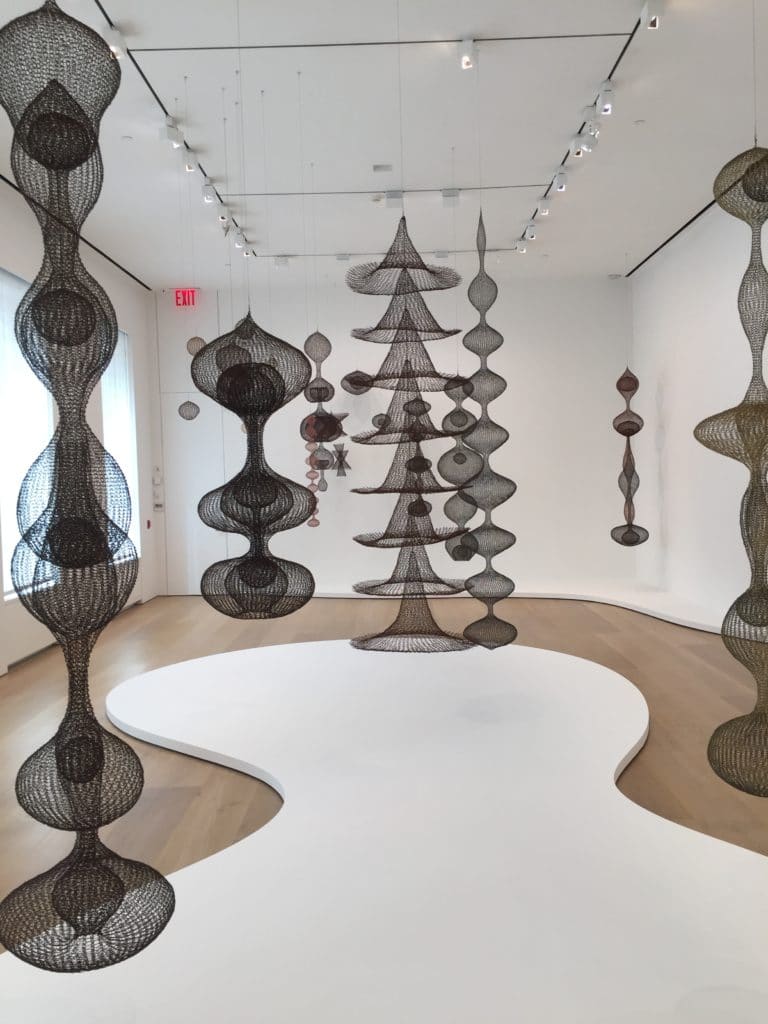
Ruth Asawa, installation. David Zwirner Gallery, New York.
Bay area legend, Ruth Asawa is known for her intricate sculptures based on sinuous organic forms. Using galvanized wire, stone, and bronze, Asawa crafted nest-like works inspired by native Mexican basket-weaving techniques.
The perceptual demands of these compelling works are intense and reward sustained looking: the blues in Ad Reinhardt’s paintings appear to change before one’s eyes, influenced by subtle shifts in color within each canvas and in neighboring works. Reinhardt paired tones of blue that are so similar that it may take minutes to see they are not the same, creating resonant compositions that challenge the limits of perception.
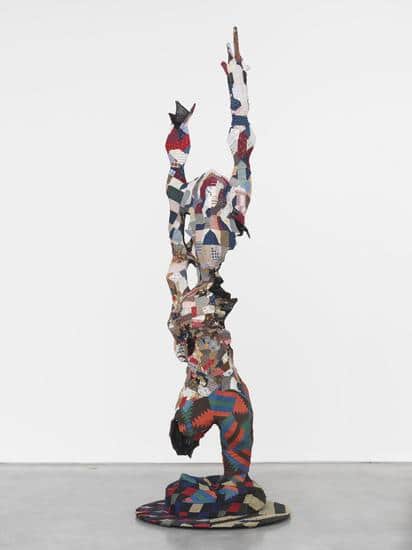
Sanford Biggers, “Selah”, 2017, antique quilt fragments, sequins, aquaresin, steel. At Marianne Boesky Gallery in New York.
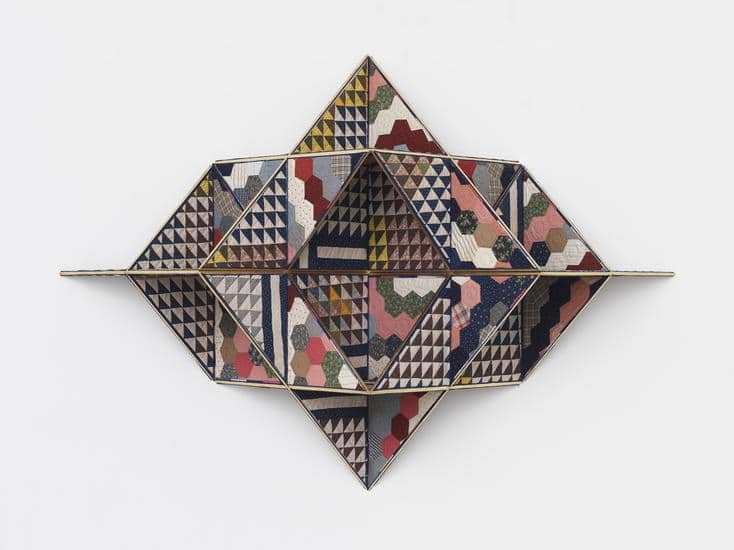
Sanford Biggers, “Khemetstry”, 2017, antique quilt, birch plywood, gold leaf. At Marianne Boesky Gallery in New York.
For his first solo show at Marianne Boesky Gallery, Sanford Biggers’ practice encompasses installation, film, drawing, sculpture, original music, and performance. His work deals with well-recognized social, political, and cultural topics which he reinterprets, highlighting new narratives. His signature antique quilts signifying bodily protection among other metaphors here are folded into more complex forms with pocketed niches suggesting hidden histories. Biggers’ work is as visually compelling as it is conceptually complex, taking viewers on a journey from the initial aesthetic encounter through embedded layers of meaning to create what he terms, “a future ethnography.”
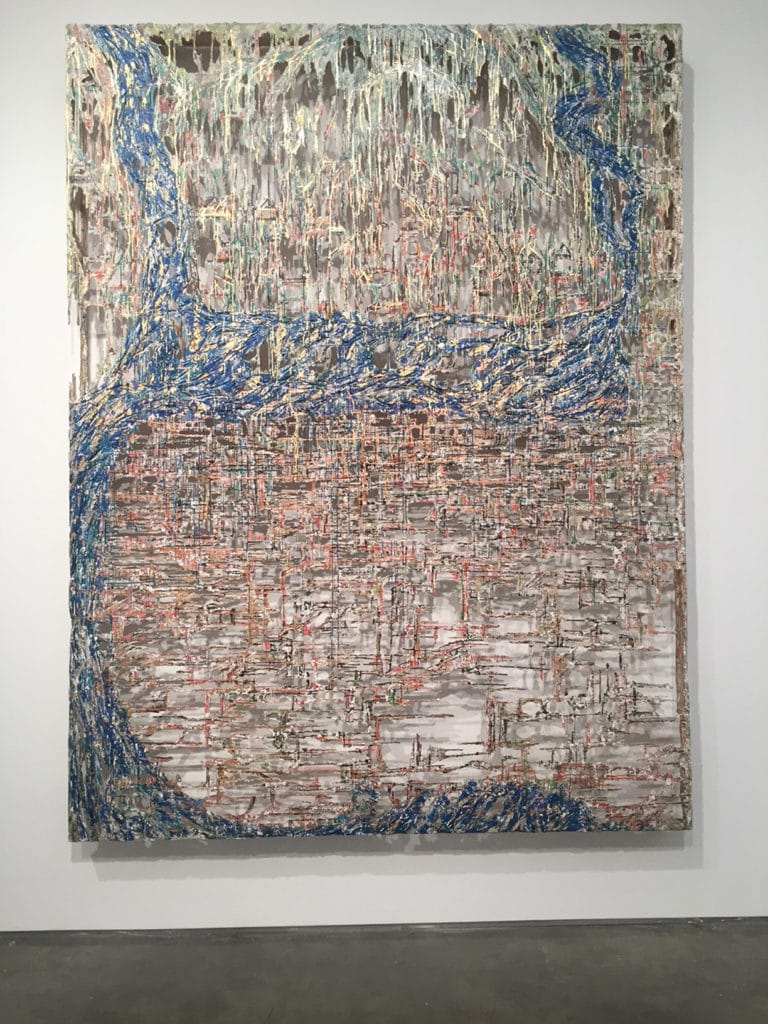
Diana Al- Hadid, “Woven City”, 2017, polymer gypsum, fiberglass, steel, plaster, gold leaf, copper leaf, painter’s tape, pigment. At Marianne Boesky Gallery in New York.
Syrian born and currently living Brooklyn, artist Diana Al-Hadid uses everyday materials, such as plaster, plywood, and cardboard, to create monochromatic, room-sized structures that seem to rise, fall, and ooze all at once. Simultaneously suggesting a sci-fi future and recalling a mythical past, the pieces combine architectural references like church spires, columns, and broken plinths with simulated fabric drapery and melting wax.
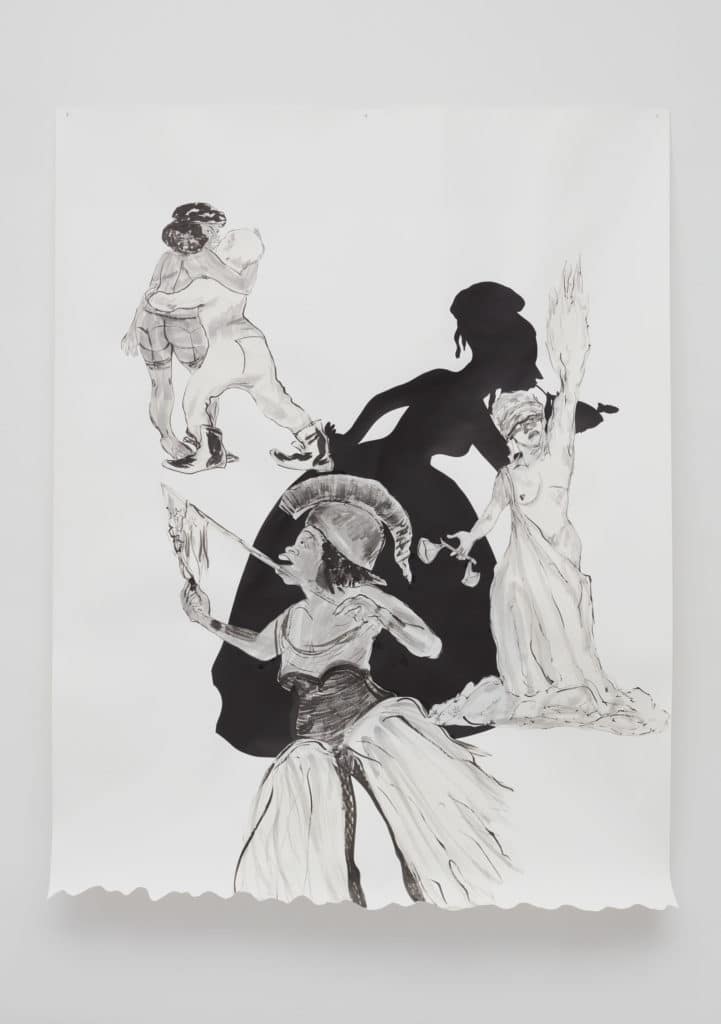
Kara Walker, “Libertine Alighting the World”, 2017, sumi ink and collage on paper. At Sikkema Jenkins in New York.
Kara Walker is known for creating black-and-white silhouette works that invoke themes of African American racial identity. The works are candid investigations of race, gender, sexuality, and violence. Working in collage, Walker cuts out and affixes black or white paper directly to gallery walls, and utilizes light projectors to cast viewers’ own shadows into her silhouetted narratives, creating a deeply engaging and profoundly thought provoking experience.
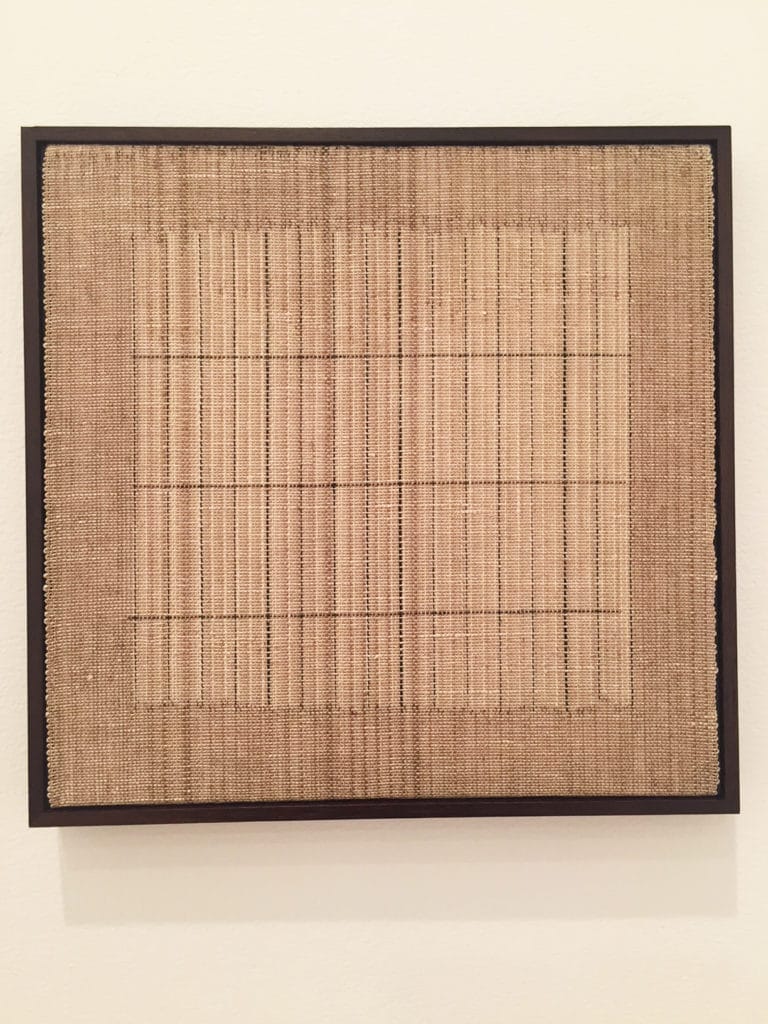
Kay Sekimachi, “Homage to AM, series II, #5”, 2015, linen, textile dye, permanent marker, plain weave. At James Cohan Gallery in New York.
The exhibition A Line Can Go Anywhere at James Cohan Gallery surveys the use of fiber as the primary material in the work of seven Bay Area artists. Kay Sekimachi uses the loom to construct three-dimensional sculptural forms. Inspired by her ancestral homeland of Japan, Sekimachi repeatedly returns to that ancient culture for ideas. She eschews color in order to reinforce the sculptural qualities of her forms and emphasize the natural properties of her chosen materials.
Amir Nikaravan’s work employs modernist architecture as a reference point to explore the politics of form. Manufacturing difference within standardization, singularity is exploded giving way to a series of unstable forms that trouble the ideal of Modernist purity. In this way, the works are not quite paintings, not quite sculptures, not quite furniture, not quite specific (bad) objects, but things.
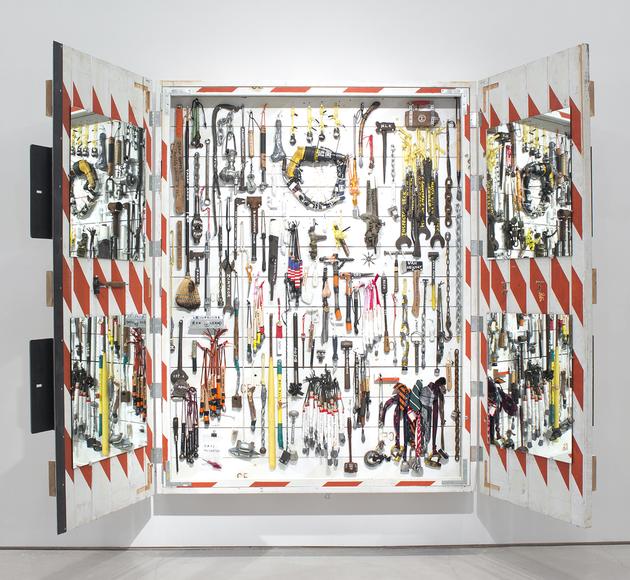
Tom Sachs, “The Cabinet”, 2014, a large wall-mounted sculpture constructed of replica ConEdison barriers. At Sperone Westwater Gallery in New York.
Sachs’s work is vigorously process-oriented. His longstanding commitment to bricolage, an art of making things out of what is ready to hand, is one expression of a studio ethos centered on labor, both as guiding principle and as symbolic currency. The cabinets in this exhibition suggest altars or shrines bringing modern-day ritual objects together with the artist’s autobiographical memorabilia. Sachs elevates these humble items, which are either ready-made or fabricated from modest materials, into cult artifacts or icons.
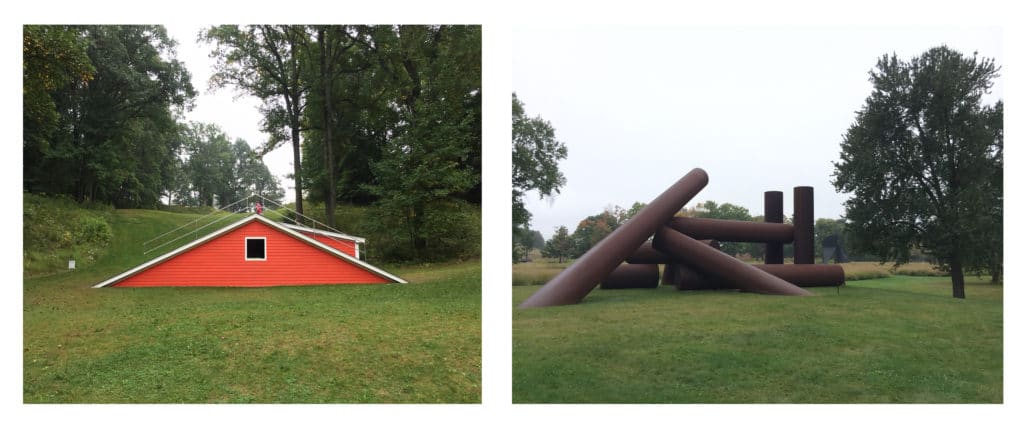
Heather Hart “The Oracle of Lacuna”, 2017, (left) and Alexander Liberman, “Adonai”, 1970- 71, (right) at Storm King Art Center in New Windsor, New York.
Fall is a great time to visit the renown Storm King Art Center with the changing colors all around. Heather Hart’s temporary installation felt poignant as so many extreme environmental events are occurring. This work is inspired by storytelling traditions, ideas of home, and narratives that add to, or even contradict, official written history. The roof is a recurring form in her work: it is a space between the earth and sky, between shelter and danger, between private and public.
Alexander Liberman’s three large-scale sculptures at Storm King reflect his studies in architecture, painting, and photography, along with his exploration of readymade, industrial forms.
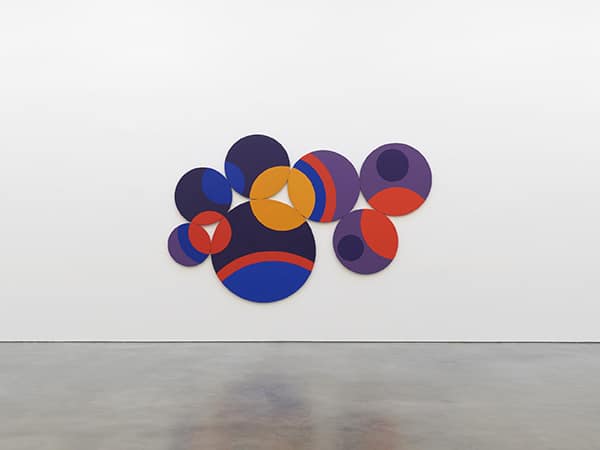
Leon Polk Smith, “Constellation Twelve Circles”, 1969, acrylic on canvas. At Lisson Gallery in New York.
Considered one of the founders of the hard-edge style of abstract art, Leon Polk Smith rose to prominence in the 1960s with his distinctive shaped canvas series — the “Correspondences” and the “Constellations”.
Bortolami’s beautiful new West Village gallery space featured the work of Barbara Kasten. For this show, she created abstract interior environments where the interplay of assembled light, objects, and mirrors forms the illusory subject of her images.
Caris Reid’s work deploys symbolism and pattern to explore femininity throughout history and across cultures. The female figures directly meet the eye of the viewer and impress with the strength of their pose. These female archetypes are covered with iconography such as cats, flowers, eyes, peace signs, yin-yangs, and birds. Reid extensively researches symbols from ancient history through the contemporary emoticon. Each piece in the exhibition tells a story. Sub Rosa a Latin term meaning “under the rose,” denotes confidentiality. A rose painted on a ceiling, carved into a confessional, or hanging in a room swears the proximate individuals to secrecy.
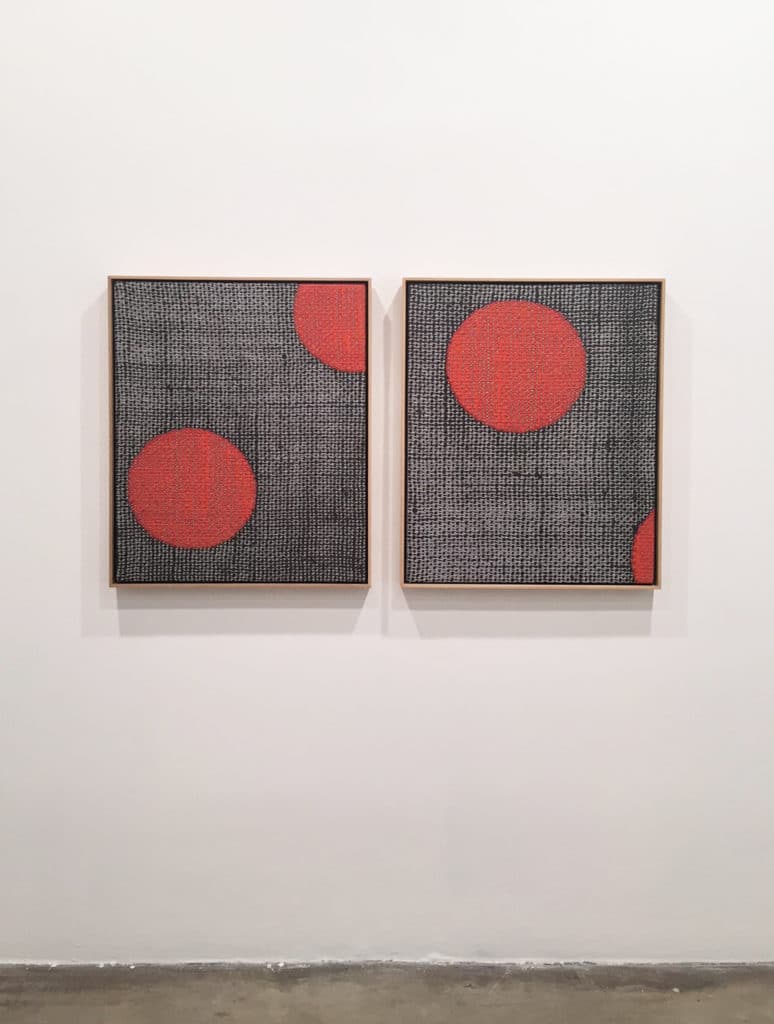
Lisa Oppenheim, “Jacquard Weave (Polka Dots)”, 2017, jacquard woven cotton, mohair and linen textile in wood frame. At Tanya Bonakdar Gallery in New York.
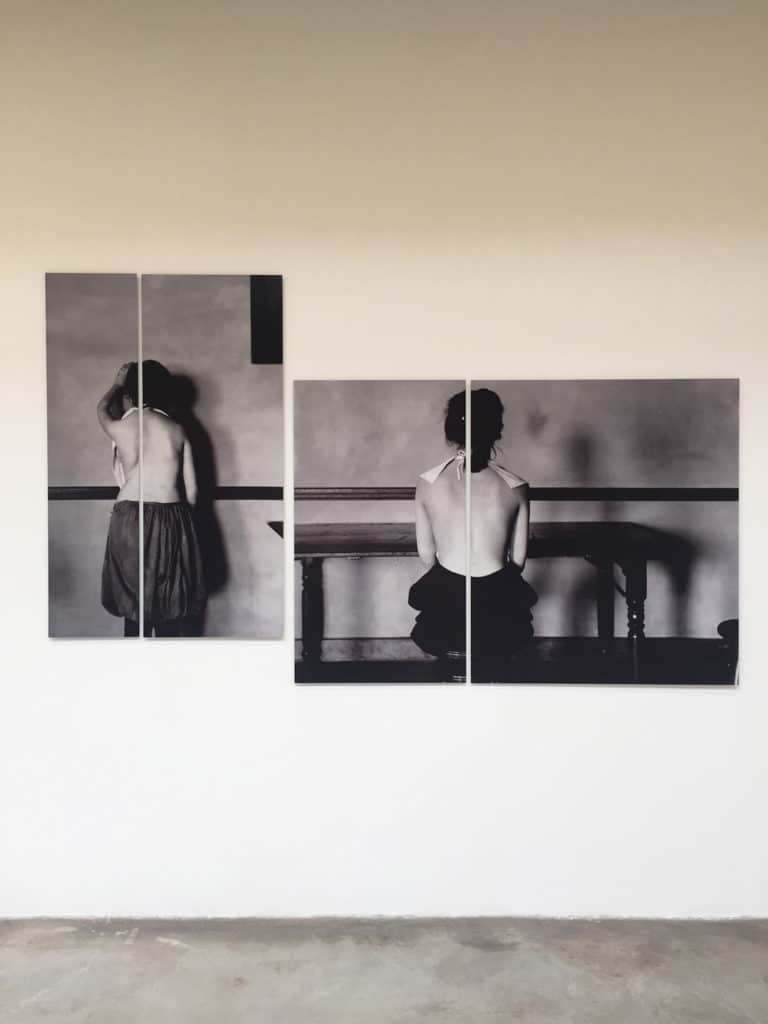
Lisa Oppenheim, “Correct posture for 4663. Need for advice of examining physician”, 2016, dye sublimation print on aluminum. At Tanya Bonakdar Gallery in New York.
The exhibition features three new bodies of work from Lisa Oppenheim that explore themes related to the body and labor within the history of photography and American textile manufacturing. The photographs depict the backs of textile workers taken by documentary photographer and sociologist Lewis Hine. In 1915, Hine produced portraits of textile workers in the Boston area to illustrate the insalubrious effects of textile manufacturing on young women’s bodies. Oppenheim investigates this particular material history as it relates specifically to women’s work. Oppenheim uses the photographs made from these vintage fragments as a basis for translating them back into textiles. With each iteration, the colors are inverted: the photograph is the color negative of the original textile, whose colors are again inverted in the programming of the Jacquard loom compositions. The resulting color palettes contribute to the complexity of one’s encounter with each surface. Through her own processes of translation, Oppenheim performs the relationship of the body to mechanical production absent in Hine’s photographs.
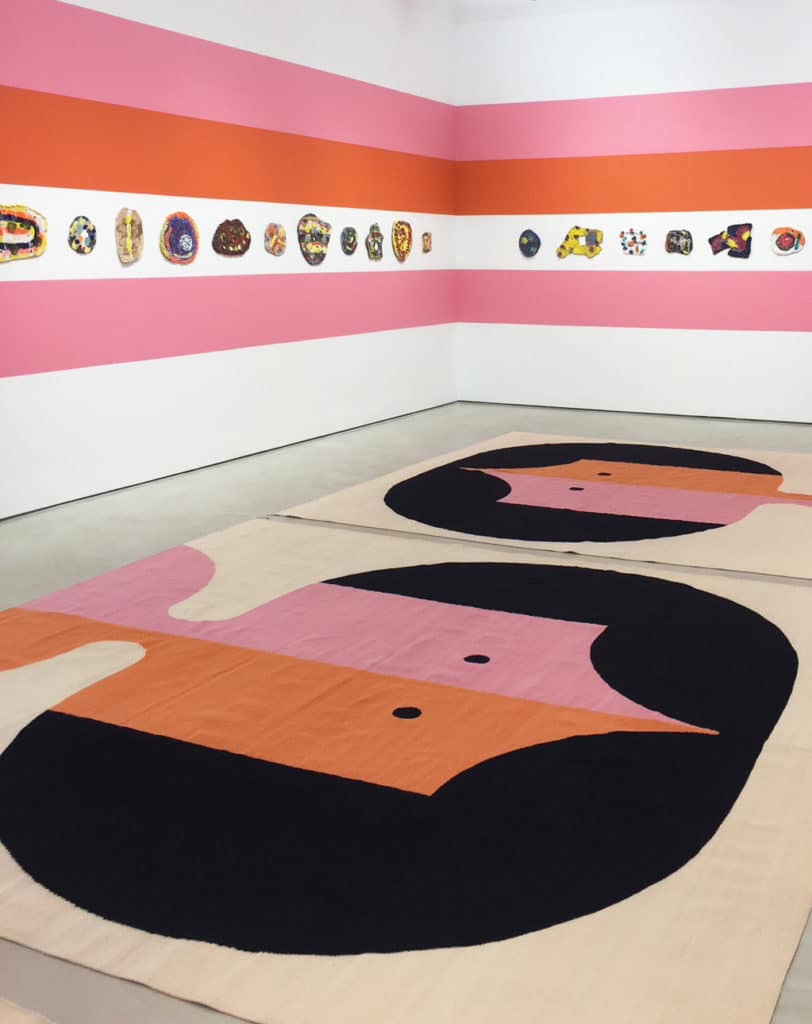
Installation view of Polly Apfelbaum, “The Potential of Women”, at Alexander Gray Associates in New York.
The exhibition features all new work from the artist, including gouache drawings, hand-woven rugs, and wall-mounted ceramics. The key visual motif comes from the 1963 book, The Potential of Woman, published in conjunction with a symposium of the same name. With the recurrent aesthetic of accumulation and diverse color saturations, Apfelbaum expands the visuals of the political landscapes surrounding the 2017 election and its resulting activism. Collectively, her densely populated drawings, row of ceramics, pay homage to the recent resurgent prominence of women’s marches and enforce the power of community to engage in collective action and activism.
It’s a pleasure to share some of the really exciting and thoughtful work being shown outside of the Bay Area this fall. Be sure to also check out our monthly “To Do List” blog posts about art events and exhibitions in the Bay Area and support our local community by getting out and visiting the various art institutions featured.
